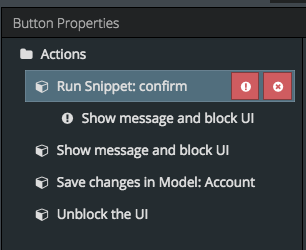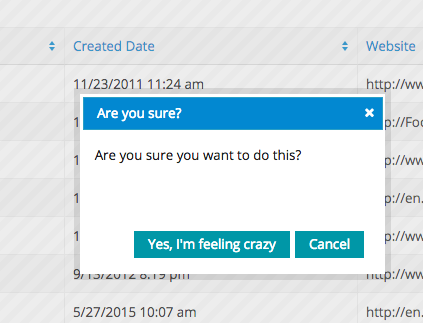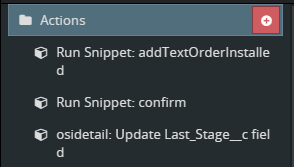Hi,
I have created hundreds of popups only to have an ‘Are you sure you want to do this?’ popup.
It would be nice if this is an action with a text to show and 2 subsets of sub-actions, one for “Yes I’m sure” and the order one for the “No, I’m not”.

Hi,
I have created hundreds of popups only to have an ‘Are you sure you want to do this?’ popup.
It would be nice if this is an action with a text to show and 2 subsets of sub-actions, one for “Yes I’m sure” and the order one for the “No, I’m not”.

Yes!
And the answer returns true/false to the action framework. If true, continue with the sequence, if false, move to the “on error” sequence.
Definitely agree, a “Confirmation Popup” action would be very useful.
I’m facing this now. It seems like there is a choice between using an ugly Javascript “confirm” in a snippet and making a Skuid popup.
I tried to find a middle ground by creating a jQueryUI confirm dialog in a snippet which looked great and even had the Skuid theming we’re using. I thought I was pretty clever until I realised those can’t be made synchronous. It can’t return a true/false to the action framework, so execution returns to the action framework in the background while the dialog is shown.
I’d love to see this addressed, although in our case we only want to show the “are you sure” if certain criteria are met when saving. E.g. “Are you sure you want to close this case?” As I understand the action framework, the only way to make actions conditional is to reproduce the whole button with different rendering conditions, which is also problematic.
So while a simple confirmation dialog (allowing configuration of title, text and button text) would help it would be even more powerful if we could only show it conditionally. Then I guess you’re getting into the whole world of conditional actions, which the action framework doesn’t seem to touch on yet. So that might be a separate request, although tied to this one for our purposes.
Ryan, your Snippet approach could return a jQuery Deferred Promise, which you would resolve / reject when the user clicks button(s) on the popup, following the approach described in this post:
https://community.skuid.com/t/block-ui-and-show-message-until-sforce-connection-remote…
For example, here we have a “Yes I’m feeling crazy” button that will resolve the Promise and allow subsequent Actions in sequence to occur, as well as a “Cancel” button that will reject the Promise, calling any On-Error Actions defined:
var $ = skuid.$;
var params = arguments 0];
var dfd = $.Deferred();
$(‘’).text(“Are you sure you want to do this?”).dialog({
resizable: true,
height: 180,
modal: true,
buttons: {
“Yes, I’m feeling crazy”:function(){
$(this).dialog(“close”);
dfd.resolve();
},
“Cancel”: function(){
$(this).dialog(“close”);
dfd.reject();
}
}
});
return dfd.promise();


Excellent, thanks Zach!
This seems like a better solution to the original issue than the workaround of creating a popup for each confirmation, so long as you’re comfortable with Javascript.
A built-in confirmation action would be easier, but this is more flexible as it allows the confirmation to only be shown under certain conditions.
Yes, It’s a much better solution.
Playing with empty templates and JavaScript I have manage to change the message of the dialog to not to create the same functionality several times:
Create a empty template component and grab the id
Use a snippet to set the html of the template
$("#sk-3Db3Yi-1594").html("This action will allow the technical team to start testing this order.
Do you want to continue?");
Launch the dialog on that id
$('#sk-3Db3Yi-1594').attr('title','Are you sure?').dialog({ ...});
So in the action framework you execute the snippet to set the text and then the snippet to show the confirm popup.
It works like a charm and the logic code is in one snippet.
I’ve found a problem with this approach when it’s used in a Skuid popup.
After the jQuery dialog is closed, the “Close” button on the Skuid popup no longer closes the popup.
I think the problem is that the “Close” button uses the “Close topmost Popup” action. It seems that the $(this).dialog(“close”); code is interfering with that action.
I’ve changed the action to “Close all Popups” and now the “Close” button works again.
Awesome thread! So Pablo, you have one generic Confirm snippet you can run in any situation, but then you’ve got a unique snippet for each different use of the Confirm box that sets your text for that template?
Where do you create the initial empty Template component to grab the id? Do you have to do this for each unique snippet or just for the one Confirm snippet?
Would you be willing to post the full snippets of your two? Thanks!
I do the same thing all the time… I do this exact thing the most but also I have confirmation windows with ROWS in a table that will be modified and give them a Row count of total edits to commit.
Ooh! Neat idea. I wanted to do something similar with a Delete button, but couldn’t figure out best way to show all records from several different objects there are about to be deleted, for example, delete and Opportunity, and related Account, and Contact, and several custom objects all at once.
Anyone know if there’s something to “show all records that have marked for deletion = TRUE” ?
The way i do it is create a UI only model with UI Only fields and just loop the model(s) and do the CreateRow() on the UI Only model and put in rows for the Confirmation display window. As long as you do the loops and createrow command before popping the popup that renders the table it is very fast, if you do the createrow command with the destination table rendered it will be very slow do to each row having to rerender the skootable. Its a very nice way to tally up changes or insert chunks etc… I then usually use a custom renderer to make the text black so it doesnt look like the unsaved changes fonts.
@[Jack Sanford] – You can use the isRowMarkedForDeletion() Model prototype method to check if a given row is marked for deletion — see the docs. So you could do it like this:
var model = skuid.$M(‘MyAwesomeModel’);
var allRowsMarkedForDeletion = skuid.$.map(model.getRows(),function(row){
if (model.isRowMarkedForDeletion(row)) return row;
});
console.log(allRowsMarkedForDeletion);
Thanks Jarrod for blowing my mind! and thanks Zach for providing some instructions for putting it all together.
This is a great situation where having the ability to write “custom actions” would be incredibly valuable. The “custom action” could have a couple of properties (e.g. title, message, OKbuttonText, CancelButtonText) and then display the dialog as Zach outlined. The solutions that folks have used (custom popup for each scneario, various templates to show/hide, specific snippets, etc.) all work but are a lot more work than should be necessary for a simple confirm dialog.
Hopefully a stock action will be added to the action framework but outside of waiting for that to be added, if you could write your own actions (“custom action”), the solution for confirm dialog could be developed in less than 30 minutes and be completely portable to all title/message situations.
+1 for “Custom Actions” 
I can’t get this to work. Can someone take a look at my snippet?
var $ = skuid.$;var openModel = skuid.$M('Opening') || skuid.$M('Open'),<br> openRow = openModel.getFirstRow();<br> <br>//get list of empty fields:<br>var emptyFields = =];<br>if (!openRow.Date_of_Birth__c) {emptyFields.push('Date of Birth');}<br>if (!openRow.LMP__c) {emptyFields.push('LMP');}<br>if (!openRow.Primary_Phone__c) {emptyFields.push('Primary Phone');}<br>console.log(emptyFields);<br>if (emptyFields.length){<br> var dfd = $.Deferred();<br> $('').text("The following fields are empty: " + emptyFields.join(", ") + ". Are you sure you want to continue?").dialog({<br> title: "Warning: Fields Are Empty",<br> resizable: true,<br> height: 180,<br> modal: true,<br> buttons: {<br> "Continue with empty fields": function(){<br> $(this).dialog("close");<br> dfd.resolve();<br> },<br> "Cancel": function(){<br> $(this).dialog("close");<br> dfd.reject();<br> }<br> }<br> });<br> return dfd.promise();<br>}
I’m successfully creating the $.Deferred(), but the dialog never pops up (so it can’t resolve).
I had to create an empty template component and use it to lauch the dialog:
<br /> $('#[IdOfTheTemplate]').text("The following fields are empty: " + emptyFields.join(", ") + ". Are you sure you want to continue?").dialog({ ...
Hi jack, sorry for the delay…
I have the empty template at the end of the page, just to have an empy div to play with.
Then I have

The first snippet changes the .html() of the div, this will ve the content of the dialog.
The second snippet launches the dialog
and the next snippets will be executed if the response is resolve.
Hey Matt,
I’ve done popups just in Javascript without a template component. Try this, it’s my working code with your text inserted. I think the main difference is in the first line.
$('<div />').html('The following fields are empty: ' + emptyFields.join(', ') + '. Are you sure you want to continue?').dialog({
title: 'Warning: Fields Are Empty',
modal: true,
resizable: false,
width: 450,
height: 180,
buttons: n{
text: 'Continue with empty fields',
click: function () {
$(this).dialog("close");
dfd.resolve();
},
}, {
text: 'Cancel',
class: 'nx-button-secondary',
click: function () {
$(this).dialog("close");
dfd.reject();
},
}]
});
}
Thanks, Pablo! That worked.
you are welcome ,
@ryan using $(‘
Here’s a generalised confirmation popup function that can be added to inline Javascript and then called from snippets or inline Javascript. I’m using this routinely now.
function popupConfirmation(dfd, title, text, confirmButtonText, cancelButtonText) {
var $ = skuid.$;
$('<div />').html(text).dialog({
title: title,
modal: true,
resizable: false,
width: 450,
height: 200,
buttons: n{
text: confirmButtonText,
click: function () {
$(this).dialog("close");
dfd.resolve();
},
}, {
text: cancelButtonText,
class: 'nx-button-secondary',
click: function () {
$(this).dialog("close");
dfd.reject();
},
}]
});
}
For those interested in how custom action support might work for this particular use case, check out https://community.skuid.com/t/custom-action-support?rfm=1&topic_submit=true.
Why isn’t this under consideration? Strange no?
Enter your E-mail address. We'll send you an e-mail with instructions to reset your password.